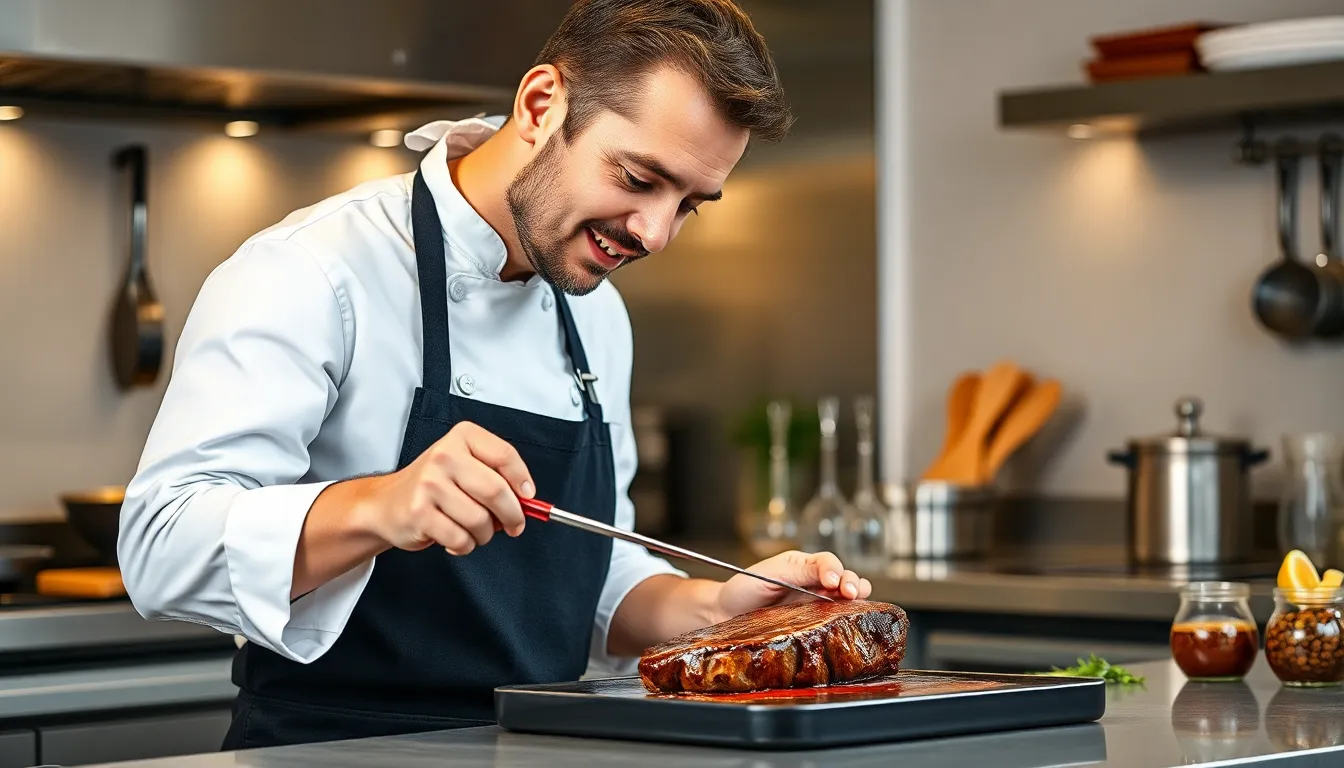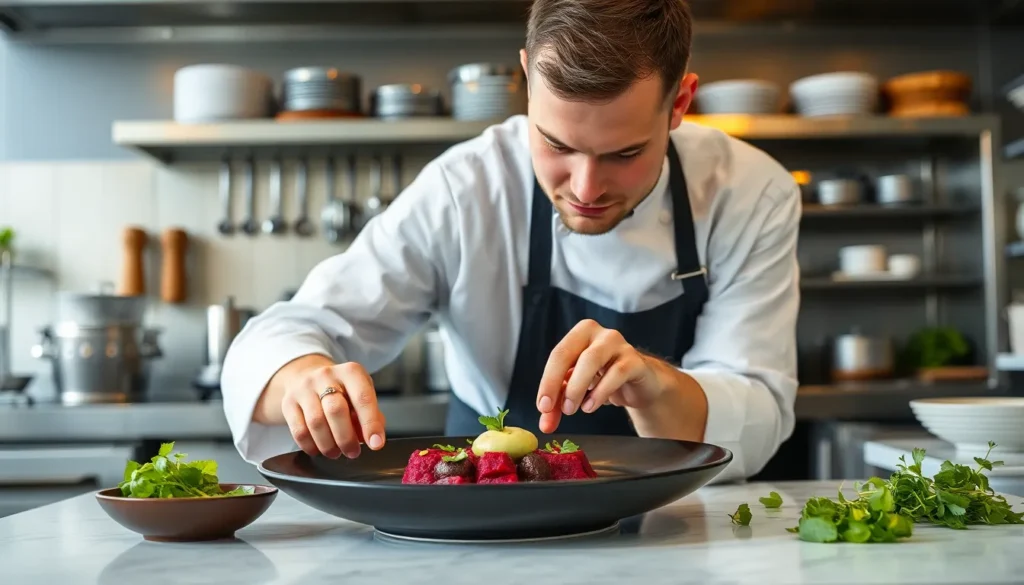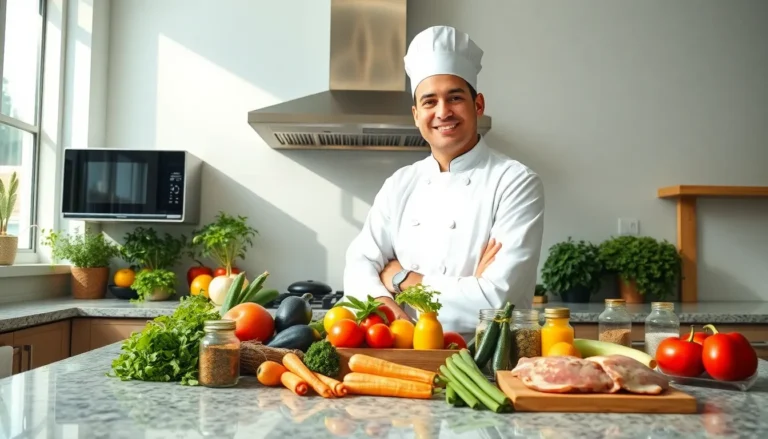Table of Contents
ToggleIn the world of culinary arts, advanced cooking is where the magic truly happens. It’s not just about boiling pasta or flipping pancakes; it’s about transforming ordinary ingredients into extraordinary dishes that make taste buds dance. Imagine whipping up a soufflé that rises like a fluffy cloud or mastering the art of sous-vide to achieve perfect steak every time.
What Is Advanced Cooking?
Advanced cooking represents a specialized approach within the culinary arts. Techniques play a crucial role in this realm, allowing chefs to transform simple ingredients into extraordinary dishes. Creativity fuels the process, encouraging culinary artists to push boundaries. Mastering complex methods, such as making a soufflé or utilizing sous-vide cooking, becomes essential for elevating flavors and presentations.
Precision in cooking techniques allows for enhanced control over textures and tastes. Sous-vide cooking, for example, involves vacuum-sealing food in a bag and cooking it at a low temperature for an extended period. This method results in consistent doneness and intensified flavors. The delicate nature of a soufflé illustrates another advanced technique, requiring a keen understanding of egg whites and proper folding methods to achieve a light, airy dish.
Plating also becomes an art form in advanced cooking. Chefs skillfully arrange components to create visually stunning presentations. Utilizing colors, shapes, and textures maximizes the appeal of the dish. Ingredients must be chosen not only for taste but also for visual harmony.
Flavor combinations further define advanced cooking. Pairing complementary ingredients can result in unexpected profiles, enhancing the overall dining experience. Chefs experiment with spices, herbs, and cooking methods to create innovative dishes.
By mastering these techniques, chefs elevate their culinary capabilities. Advanced cooking fosters confidence in transforming ideas into tangible, remarkable dishes. Experimentation and practice lead to the refined skills necessary for success in advanced culinary endeavors.
Techniques Used in Advanced Cooking

Advanced cooking techniques transform culinary experiences. Chefs utilize precision and creativity in every step.
Sous Vide Cooking
Sous vide cooking involves vacuum-sealing food to ensure even cooking. This method allows chefs to maintain consistent temperatures, which results in perfectly cooked dishes. For example, cooking a steak at 130°F for 2 hours ensures it reaches the desired doneness throughout. Chefs can also infuse flavors by adding herbs or spices into the vacuum-sealed bags. Controlling temperature precisely enhances texture and retains moisture, making meals more flavorful and tender. This technique showcases the intersection of science and cooking, appealing to culinary enthusiasts looking for perfection.
Molecular Gastronomy
Molecular gastronomy involves experimenting with food’s physical and chemical properties. Chefs use techniques like spherification to transform liquids into caviar-like spheres, creating unique textures. Emulsification allows for creating foams and sauces that elevate dishes. For instance, a balsamic vinegar foam can add both flavor and visual appeal. Techniques such as sous-vide and dehydrating further expand possibilities in molecular gastronomy. Chefs often incorporate unexpected flavors and presentations, challenging traditional culinary norms. This playful approach encourages creativity, inviting diners to experience familiar foods in intriguing new ways.
Tools and Equipment for Advanced Cooking
Advanced cooking requires specialized tools and equipment to achieve precision and creativity in the kitchen. These items enhance techniques and elevate the culinary experience.
Essential Kitchen Gadgets
Conventional tools may not suffice for advanced culinary tasks. Immersion blenders enable smooth purées, while digital thermometers ensure accurate temperature readings. Sous-vide immersion circulators provide controlled cooking for meats or vegetables. Mandoline slicers facilitate uniform cuts for consistent cooking results. Spice grinders enhance flavors by allowing fresh ingredient use. Kitchen scales measure ingredients precisely, improving recipe accuracy. Each gadget contributes unique benefits that streamline the cooking process and encourage experimentation.
Advanced Cookware
Quality cookware becomes essential for advanced cooking techniques. Non-stick skillets prevent sticking during delicate cooking, while cast iron pans retain heat, enhancing caramelization. Copper-bottomed pots distribute heat evenly, ensuring consistent cooking results. Heavy-duty baking sheets withstand high temperatures, perfect for roasting vegetables, and stainless steel saucepans offer durability and versatility. Enamel-coated Dutch ovens excel at braising, offering steady heat retention. Each piece of cookware plays a crucial role in executing complex recipes and achieving exceptional outcomes.
Recipes to Try for Advanced Cooking
Exploring advanced cooking techniques leads to remarkable dishes that impress. Here are two categories of recipes to elevate culinary skills.
Appetizers
Crafting appetizers allows creativity to shine. Consider preparing a beetroot tartare served with a smooth avocado cream. This dish combines earthy flavors with a refreshing twist. Another option is a lobster bisque enriched with brandy, using homemade stock for depth. Precision in timing is crucial as flavors develop during cooking. Try a delicate foam as a garnish to elevate the presentation. These refined appetizers set the stage for sophisticated dining experiences.
Main Courses
Creating main courses involves mastering complex techniques. Duck confit merits attention with its rich flavor profile and tender meat. Slow-cooking the duck in its fat ensures moisture and exquisite taste. Another enticing recipe features a rack of lamb with a herb crust, bringing together fresh rosemary and thyme for an aromatic touch. Sous-vide techniques enhance the doneness and juiciness of the lamb, offering consistent results. Layering flavors through sauces or reductions adds depth, culminating in impressive main courses.
Advanced cooking opens up a world of creativity and precision in the kitchen. By mastering intricate techniques and utilizing specialized tools, chefs can elevate their culinary creations to new heights. The blend of science and artistry allows for unique flavor combinations and stunning presentations that impress diners.
As chefs continue to explore and innovate, they push the boundaries of traditional cooking. This journey not only enhances their skills but also transforms simple meals into extraordinary experiences. Embracing advanced cooking techniques can lead to a deeper appreciation for the culinary arts and inspire a lifelong passion for cooking.








